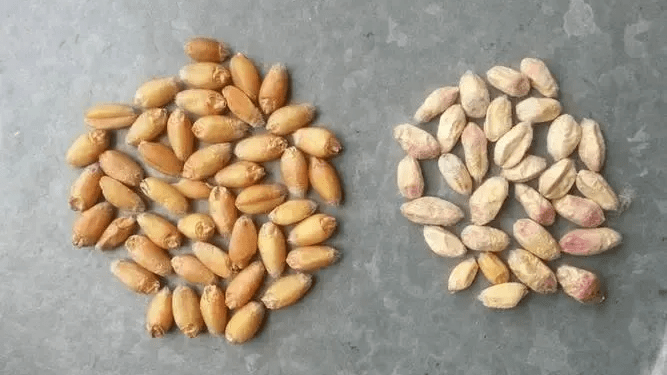A Comprehensive Guide to Recognizing and Assessing Wheat Quality for Feed Production
Fusarium Head Blight
1. Fusarium Head Blight: Gray Grain
Gray grains are characterized by their shriveled, shrunken appearance, and dull white color. These grains are loose, brittle, and less silty with a gray tint. They exhibit a light specific gravity and can often be separated by wind sieve and water drift. This condition results from bacterial infection during the flowering stage under high temperature and humidity. The infection leads to the growth of gray hyphae without spores, causing the grain to turn gray and white.
2. Fusarium Head Blight: Red Grain
Red grains, also known as mycored granules, display a pink, rose red, or orange red hue originating from the embryo and spreading to other parts of the grain. These grains are deflated and thin, with varying degrees of cortex shriveling and loose, opaque organization. This coloration occurs due to bacterial infection during the flowering stage, where favorable temperature and humidity conditions lead to extensive conidia multiplication and pigment secretion.
3. Fusarium Head Blight: Gray-Green Grain
Gray-green grains exhibit a dark bluish-gray color on the cortex, with a matte powdery appearance. The grain is shriveled, loose, and qualitatively changed. This defect arises when pathogens infect wheat during the milk stage, absorbing nutrients and altering the grain’s characteristics.
Mildew in Wheat
4. Mildew Grain
Mildewed grains are biprismatic, awn-like, and account for about half the size of normal wheat grains. They are lightweight, smaller, and often resemble wheat skins. These grains are black, break easily under pressure, and emit a distinct odor. Mildew infection leads to a notable decrease in grain quality and nutritional value.
Imperfect Grains
5. Imperfect Wheat Grain
Imperfect grains are identified by their visual defects when inspected over a 10 cm² area. Typically, about 2.5% of the grains in a sample are found to be incomplete or flawed. Common imperfections include concave, wrinkled, or deeply sulcus grains, accounting for approximately 1.4% of the total. These defects include insect erosion, breakage, mildew, diseased spots, and sprouted grains, which significantly affect the grain’s quality and suitability for feed.
Error




